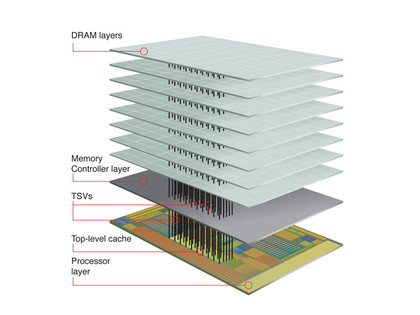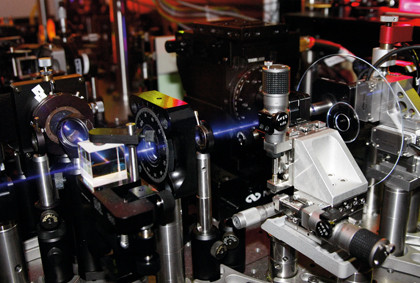3D memory

3D SANDWICH: 3D memory uses the same principle as 3D processors, with DRAM layers allowing for greatly increased density and efficiency
When you read this, Samsung's latest 8GB memory modules will be about to hit the market. Using the same TSV technique IBM pioneered to move processors into the third dimension, Samsung bonded memory chips together, allowing them to communicate vertically.
The company claims that its DDR3 DIMMs will offer a 50 per cent improvement in memory density, while providing a 40 per cent reduction in energy consumption compared to conventional memory modules.
Spectacular gains
The improvements promised by Samsung's dual-layer memory modules are relatively modest because they're designed to work in conjunction with ordinary processors and standard motherboards. If these constraints are removed though, much more spectacular gains can be achieved, as Dr Dong Hyuk Woo of the Georgia Institute of Technology explains.
"A CPU is typically manufactured with a logic process optimised for speed while a DRAM is typically optimised for density," he says. "Due to such different optimisation requirements, we weren't able to implement both components on the same silicon die or chip. Thus, each chip was manufactured into an individual package, and later mounted on the same motherboard to form a system. Such separation means the number of interconnects between these two packages has been seriously limited so data bandwidth between them was also limited. Such limited data bandwidth has been called a von Neumann bottleneck."
Fortunately, Dr Woo has a solution up his sleeve. "Now, on the other hand, 3D integration allows multiple dies, built with different manufacturing technologies, to be packaged and integrated into a single package," he says.
What's more, using TSVs means the number of parallel lines connecting the main memory to the top level cache could be phenomenal - as many as 32,000 has been suggested. In his research, Dr Woo was interested in how much performance can be improved with such tight integration, which can practically eliminate the bandwidth limitation.
Get daily insight, inspiration and deals in your inbox
Sign up for breaking news, reviews, opinion, top tech deals, and more.
Working on the basis of a one layer processor, one layer for the memory controller, and four layers for the memory, he was able to demonstrate that fetching huge chunks of data from main memory to cache didn't saturate the memory bandwidth. By using such an aggressive approach, he was able to show a doubling of processor performance in many instances.
But if this technology becomes mainstream, we would essentially be saying goodbye to RAM as a system component. In much the same way that Intel's Sandy Bridge processors have eliminated the Northbridge chip, GPU and memory controller by integrating them with the CPU, if Dr Woo's vision becomes a reality, this super-chip would also include the system memory.
Meanwhile, researchers at Rice University in Texas have developed a form of flash memory with two terminals per bit instead of the three in standard memory. The benefits go beyond its inherent simplicity; the two-terminal architecture is also more suitable for building into 3D arrays.
Rice University's Professor James Tour jokes, "I've been told by [the] industry that if you're not in the 3D memory business in four years, you're not going to be in the memory business. This is perfectly suited for that."
3D data storage

COMING SOON-ISH: Overlapping blue lasers are used to record holograms in a GE micro-holographic disc
Mass storage media is flat, but even today it's not entirely two-dimensional. DVD and Blu-ray discs can both have two layers of data per side, and researchers have demonstrated 16-layer disks (400GB). But there's a limit to how far the technology can be stretched.
Although the laser beam addresses a particular layer by tight focusing, passing through several other reflective layers can seriously degrade the signal.
Holography is a means of recording a scene so that it can be viewed from any angle, providing a true 3D experience. The same technique can be used to store pages of binary data, which are selected by altering the angle at which the hologram is read.
Although we can't talk about layers, the data in a hologram is spread through the thickness of the media. This has been touted as a future method of high capacity data storage for years, but companies intent on bringing products to the market have been unsuccessful. An announcement by General Electric of a micro-holographic disk is therefore particularly interesting.
By placing microscopic holograms on a 120mm disk, it offers a significant advantage, as GE's Brian Lawrence explains:
"Because GE's micro-holographic discs could be read and played using similar optics to those in Blu-ray players, our technology will pave the way for holographic drives that could be in every home. The day when you can store your entire HD movie collection on one disc and support formats like 3D TV is closer than you think."